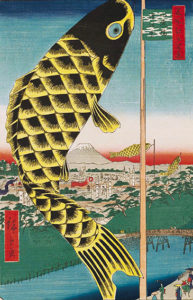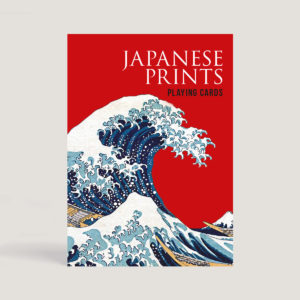JAPANESE PRINTS
 ‘All my work is based to some extent on Japanese art…’ So said van Gogh in 1888. He and the Impressionists discovered Japanese art through prints sent to Europe as mere wrapping paper (!) in packages. Their palette was transformed. Compositions adopted the low horizon, or none at all. Colour and line became crucial and would define the work of later masters, like Matisse and Picasso who revered Utamaro and Hiroshige. Monet even created a Japanese garden, Giverny. For van Gogh the Japanese print created a mood: it made ‘you feel colour differently’, made you feel ‘happier and more cheerful’ and inspired him ‘to return to nature’.
‘All my work is based to some extent on Japanese art…’ So said van Gogh in 1888. He and the Impressionists discovered Japanese art through prints sent to Europe as mere wrapping paper (!) in packages. Their palette was transformed. Compositions adopted the low horizon, or none at all. Colour and line became crucial and would define the work of later masters, like Matisse and Picasso who revered Utamaro and Hiroshige. Monet even created a Japanese garden, Giverny. For van Gogh the Japanese print created a mood: it made ‘you feel colour differently’, made you feel ‘happier and more cheerful’ and inspired him ‘to return to nature’.
ART OF UKIYO-E
Ukiyo-e means ‘Pictures of the Floating World’: images of everyday Japan, mass-produced in the Edo and Meiji periods (1615-1912), largely though colour woodblock prints, of beauties, actors, nature, heroes and courtesans (upmarket prostitutes). Originally, ukiyo was used by Buddhists to convey the ‘fleeting’ nature of life, but it came to describe the pleasures of the red light and kabuki theatre district, a louche place that was yet chic and fashionable. In 1765 the technique of using multiple colour woodblocks was perfected, resulting in luminous prints. Production required a publisher, designer, block cutter and printer. It was an exacting, skilful process that ended with a full colour print being pulled from a cherry wood block every 20 seconds – and perhaps in an edition of 20,000! For the price, to the punter, of a bowl of noodles.
SOCIAL HISTORY OF THE PRINT
 After centuries of turmoil the shoguns (military rulers) of the Edo period (1615-1868) unified Japan and brought about 250 years of peace. To ensure loyalty to the shoguns, feudal lords had to spend alternate years in Edo (now Tokyo), the capital. Their families lived there permanently – hostages if the absentee lord got uppity. So Edo’s population grew. By 1800 it was the largest city in the world, with a population of 1 million.
After centuries of turmoil the shoguns (military rulers) of the Edo period (1615-1868) unified Japan and brought about 250 years of peace. To ensure loyalty to the shoguns, feudal lords had to spend alternate years in Edo (now Tokyo), the capital. Their families lived there permanently – hostages if the absentee lord got uppity. So Edo’s population grew. By 1800 it was the largest city in the world, with a population of 1 million.
To feed their needs licensed prostitutes and theatres were housed in a walled, moated city, Yoshiwara, a bohemian place where social distinction was ignored. A new merchant class arose, with lower status than farmers and artisans (samurai were at the top) though a cut above the ‘sex workers’ and thespians. But the merchants had the loot. They became patrons of the courtesans and actors (often superstars with big fan clubs) of the new popular ukiyo culture. They paid artists to promote their clients. The prints were pure escapism, like a fanzine or glamour mag. Prints appealed to the poorer classes. They were expressive and explicit, but also inventive, often using subtle atmospheric effects of rain, snow and dusk.
LANDSCAPE
The Shogunate was brutal in its censorship of anything that might cause dissent, or encourage disobedience or frivolity (actor and courtesan prints were banned from 1842). Utamaro was banged up in 1804 for depicting an historical samurai as lecherous. Landscape prints were safer. They began in the 1820s when travel was finally permitted within Japan. They were like a postcard, a reminder of a journey.
HOKUSAI
Spare a thought for the greatest of these ukiyo-e artists, Hokusai (1760-1849), whose Great Wave adorns our cover. His life was hard. Both his wives and two children died before him. He was struck by lightning at 50, suffered a stroke in his 60s that required relearning his art, and had to pay off his grandson’s gambling debts. A fire in 1839 destroyed all his studio work. Even while drawing the Red Fuji, aged 75, Hokusai was starving because Edo was ravaged by smallpox and flood. This restless, but humble genius moved house 93 times. But he persevered. And at the end these were his last words: ‘If heaven will afford me five more years of life, then I’ll manage to become a true artist.’


